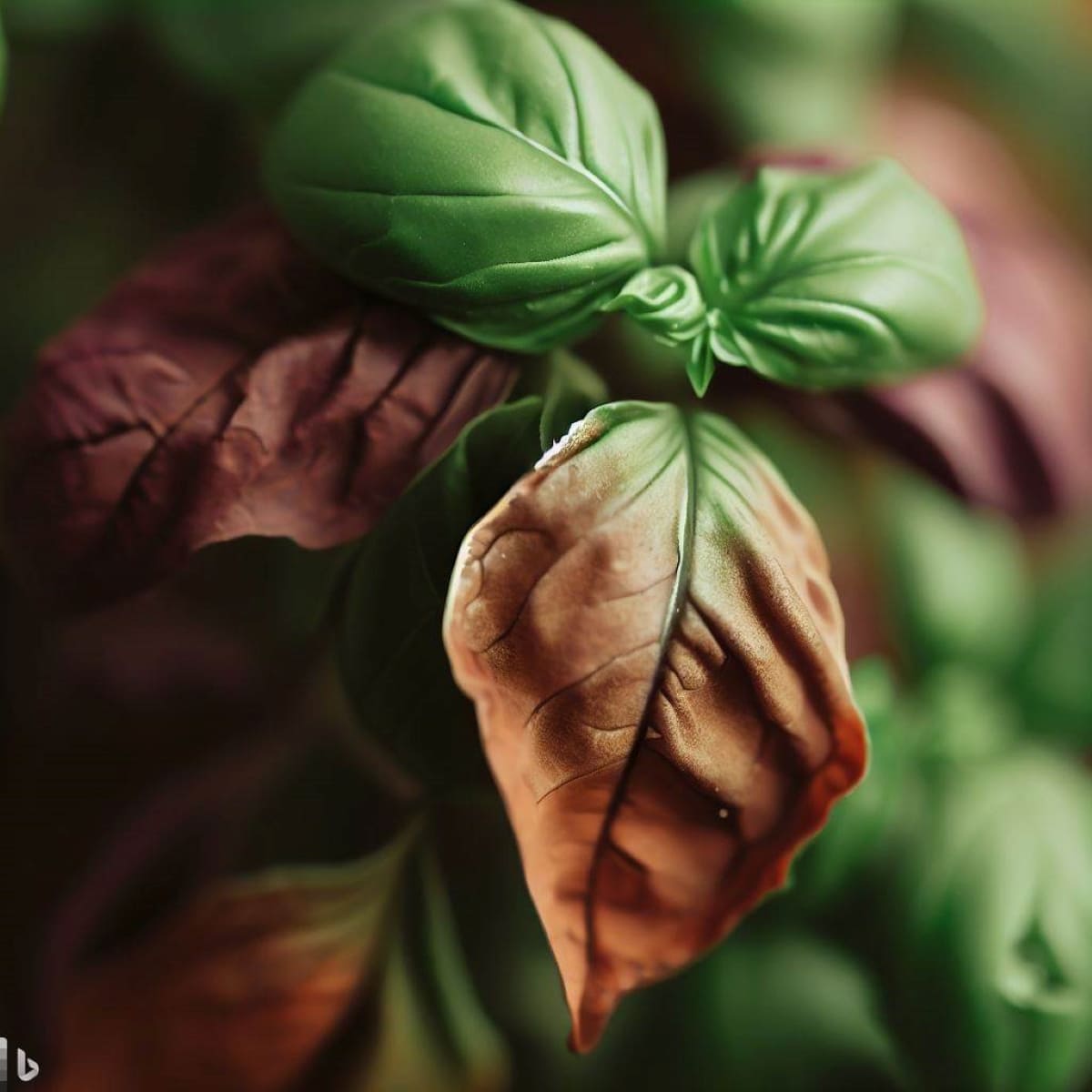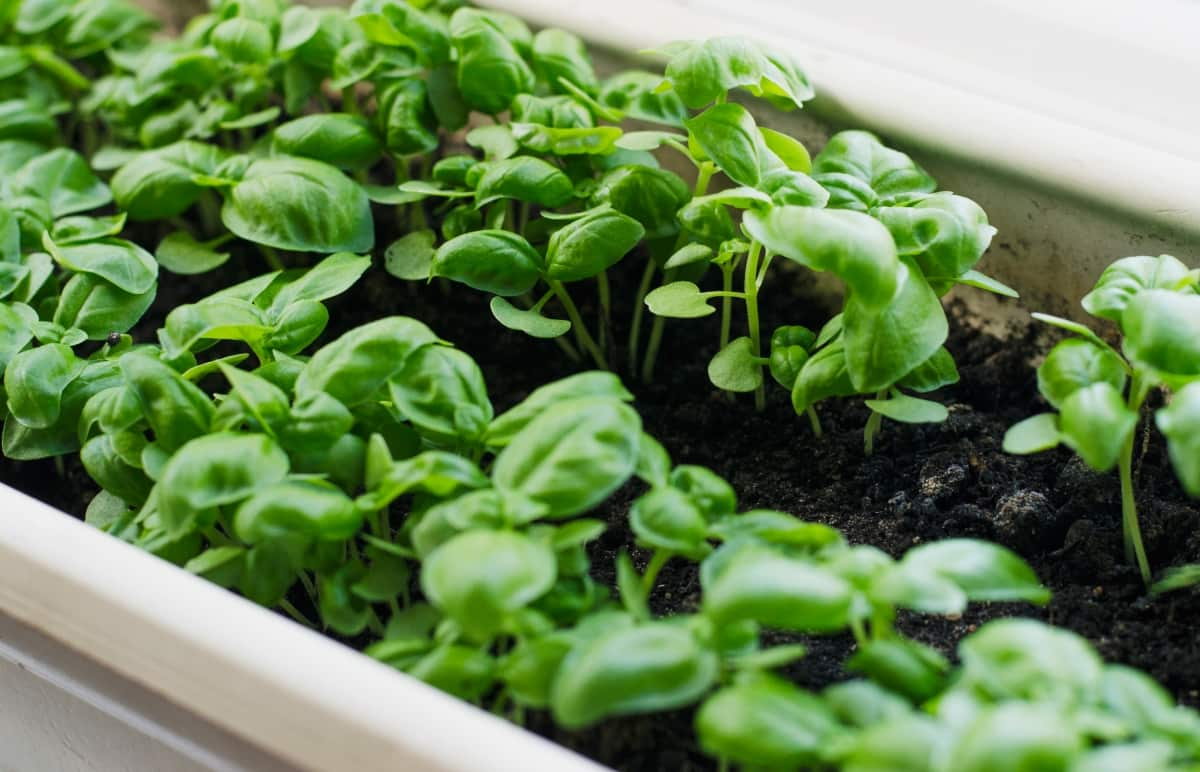Brown leaves on Basil can be a common issue that gardeners and plant enthusiasts encounter. Why Are my Basil leaves turning brown? The causes of brown Basil leaves can vary from environmental factors to pests and diseases. However, with proper care and attention, it is possible to remedy the issue and restore your Basil plants to their healthy green state.

If you notice brown leaves on your Basil plants, promptly identify the cause and implement appropriate remedies. Whether it’s adjusting watering habits, improving air circulation, or using organic pest control methods, you can take various measures to address the issue.
Introduction to Basil Brown Leaves: Understanding the Issue
Basil is a beloved herb that adds flavor and freshness to countless dishes. However, it can be concerning if you’ve noticed your Basil leaves turning brown on the edges. Understanding the issue of brown Basil leaves is crucial to address the problem effectively. Several potential causes for Basil leaves turning brown, ranging from environmental factors to pests and diseases.
Environmental Factors: Impact on Basil Brown Leaves
One environmental factor that can contribute to brown Basil leaves is temperature. Basil thrives in warm temperatures. Another environmental factor that can affect Basil leaf color is humidity levels. Basil prefers moderate humidity, so if it is grown in an environment with high humidity or low humidity, it may cause browning of the leaves. Additionally, air circulation plays a crucial role in maintaining healthy Basil plants.
Poor airflow can lead to stagnant moisture on the foliage, creating an ideal breeding ground for bacterial and fungal diseases that result in browning. Light intensity is also vital in keeping Basil leaves green and healthy. While they require ample sunlight for photosynthesis, too much direct sunlight during peak hours can scorch the delicate foliage and cause browning.
Soil Conditions: Influence on Basil Leaf Health
Soil conditions play a crucial role in the overall health of Basil leaves. The type of soil and its composition can greatly impact the growth, color, and vitality of these fragrant herbs. One common issue that can lead to brown Basil leaves is poor drainage. If the soil doesn’t drain well, it can cause waterlogged roots and ultimately suffocate the plant.
On the other hand, if the soil drains too quickly, it may not retain enough moisture for proper growth. Another factor to consider is nutrient deficiency or excess in the soil. Basil plants require a balanced supply of nutrients like nitrogen, phosphorus, and potassium for healthy foliage development.
When these nutrients are lacking or imbalanced in the soil, it can result in discolored or wilted leaves. Additionally, overly acidic or alkaline soils can negatively affect Basil leaf health. Basil prefers slightly acidic to neutral pH levels between 6 and 7. If the soil pH deviates from this range significantly, it can hinder nutrient uptake by the roots and lead to browning or yellowing of leaves.
Overexposure to Sunlight: Sunburn and Browning of Basil Leaves
Overexposure to sunlight can be a common cause of brown Basil leaves. Basil plants thrive in warm and sunny conditions, but excess direct sunlight can lead to sunburn and browning of the leaves. When Basil is exposed to intense sunlight for long periods, it can cause the leaves to become scorched and turn brown.
Excessive heat causes the plant’s cells to dry out and die. Unsightly brown spots on your once vibrant Basil leaves. To prevent sunburn and browning of Basil leaves, provide shade during the hottest parts of the day. You can use shade cloth or move your pots to a location where they receive partial shade instead.
Watering Issues: Effects on Basil Leaves
Proper watering is essential for maintaining healthy Basil plants. However, overwatering or underwatering can harm the leaves of your beloved herb. Underwatering, a common mistake many gardeners make, leads to dehydration and wilting of the Basil plant. When insufficient water is available, the leaves become droopy and turn brown at the edges. It’s crucial to regularly check the soil moisture levels and ensure that your Basil receives an adequate amount of water.
On the other hand, overwatering can drown your Basil plant and cause root rot. If your Basil leaves turn brown from the bottom up, it could be due to excessive watering. To avoid these problems, it’s important to strike a balance in watering your Basil plants. Ensure you provide enough water to reach deep into the roots and allow for proper drainage so excess water doesn’t accumulate at the base.
Nutritional Deficiencies: Causes of Brown Leaves in Basil
There are several elements that Basil plants require for proper growth, including nitrogen, phosphorus, potassium, calcium, magnesium, and iron. A lack of nitrogen is a common cause of brown leaves due to nutritional deficiencies. Nitrogen is crucial for leaf development and overall plant health. If your Basil leaves turn brown from the bottom up or have pale green veins, it may indicate a nitrogen deficiency.
Phosphorus deficiency can also lead to brown spots on Basil leaves. Without enough phosphorus, the leaves may develop dark spots or blotches. Potassium deficiency can result in yellowing edges and browning of the entire leaf surface. It affects water regulation within the plant and overall nutrient uptake. Calcium and magnesium deficiencies can cause brown spots or curling of Basil leaves. These minerals are responsible for cell structure and enzyme activation.
In case you missed it: Basil Companion Plants: What to Plant Next to Basil and What Not to Plant Next to Basil

If left untreated, an iron deficiency may manifest as interveinal chlorosis (yellowing between veins) and eventually progress to browning. Consider using organic fertilizers specifically designed for herbs or vegetables to address these nutritional deficiencies in your Basil plants. How to treat brown spots on Basil leaves? Regularly monitor soil pH levels to ensure optimal nutrient availability. Additionally, foliar sprays containing necessary micronutrients can help alleviate mineral deficiencies quickly.
Pests and Diseases: Common Culprits for Brown Basil Leaves
Regarding the health of your Basil plants, pests and diseases can wreak havoc on those vibrant green leaves. These tiny invaders and invisible pathogens can turn once lush Basil leaves into a disappointing shade of brown. One notorious pest that loves to feast on Basil is the aphid. These small insects suck the sap from the leaves, causing them to wilt and turn brown over time.
Another troublesome critter is the spider mite, which spins webs on the underside of leaves and sucks out their vital juices. Diseases like downy mildew and fusarium wilt also threaten Basil’s leaf health. Downy mildew appears as yellowish-brown spots on the upper side of leaves, eventually turning them brown and crispy.
Fusarium wilt causes wilting, stunted growth, and yellowing, followed by browning of leaves. Prevention is key when dealing with these pesky pests and diseases. Organic insecticides or repellents can help keep pests at bay without harming beneficial insects or affecting plant quality.
Improper Pruning and Harvesting Techniques: Impact on Basil Leaves
Proper pruning and harvesting techniques play a crucial role in maintaining the health of Basil plants. When these practices are not carried out correctly, they can harm the plant leaves. One common mistake is pruning too aggressively or at the wrong time. Over-pruning can weaken the plant, making it more susceptible to diseases and pests. It’s important to trim only about one-third of the plant at a time, focusing on removing any damaged or diseased leaves.
Another issue arises when Basil leaves are harvested incorrectly. Tugging or tearing at the leaves can cause damage to their structure, leading to browning and wilting. Instead, it is recommended to use clean scissors or shears to snip off individual leaves just above a node. Furthermore, harvesting too frequently without giving enough time for new growth can also result in brown leaves.
Remedies and Treatment for Brown Basil Leaves
First and foremost, addressing any environmental factors contributing to browning is crucial. If your Basil is exposed to extreme temperatures or drafts, consider relocating it to a more suitable spot in your home or garden. Providing consistent temperature and humidity levels will greatly benefit the overall health of your plant. Overwatering causes root rot and nutrient deficiencies while underwatering can cause stress on the plant.
Finding the right balance is key. Ensure that you’re watering your Basil consistently but not excessively. Use well-draining soil and avoid letting water sit in saucers or trays beneath the pot. Ensuring proper nutrition is essential for healthy Basil leaves. Regularly feed your plants with a balanced organic fertilizer for herbs like Basil. This will help provide all the necessary macronutrients and micronutrients for optimal growth.
Pests and diseases are often culprits behind brown Basil leaves as well. Keep a vigilant eye out for common pests such as aphids, whiteflies, or spider mites. If an infestation occurs, treat it immediately using natural pest control methods or insecticidal soap. Another factor worth considering is sunlight exposure; while Basil thrives in bright light conditions, excessive direct sunlight can result in sunburnt leaves leading to discoloration.
In case you missed it: Frequently Asked Questions About Basil Farming

If this is an issue, consider providing shade during peak sun hours or moving your plant to a location with filtered light instead. Improper pruning techniques can also contribute to browning leaves on Basil plant. Ensure you’re trimming correctly by snipping above leaf nodes rather than cutting randomly throughout the foliage – this encourages new growth without causing unnecessary stress.
Conclusion
Understanding the possible causes of brown Basil leaves and implementing simple remedies and treatments can help restore your plants to their vibrant green state. Regularly inspect your plants for pests and promptly address any possible infestations. Consider using natural pest control methods or organic pesticides if necessary. Always monitor environmental conditions such as temperature and sunlight exposure to provide optimal growing conditions for your Basil plants.
- Feed Your Flock for Less: Top 10 Tips to Save on Chicken Feed
- Ultimate Guide to Ossabaw Island Hog: Breeding, Raising, Diet, and Care
- Hatching Answers: The Top 10 Reasons Your Chickens Aren’t Laying Eggs
- Eggs and Economics: Breaking Down the Cost of Raising Backyard Chickens
- Defend Your Greens: Proven Methods to Keep Iguanas Out of Your Garden
- Ultimate Guide to Cinnamon Queen Chicken: A Comprehensive Guide for Beginners
- Ultimate Guide to California Tan Chicken: Breeding, Raising, Diet, Egg-Production and Care
- Ultimate Guide to Marsh Daisy Chicken: Breeding, Raising, Diet, and Care
- 10 Types of Chicken Farming Businesses You Can Start for Profits